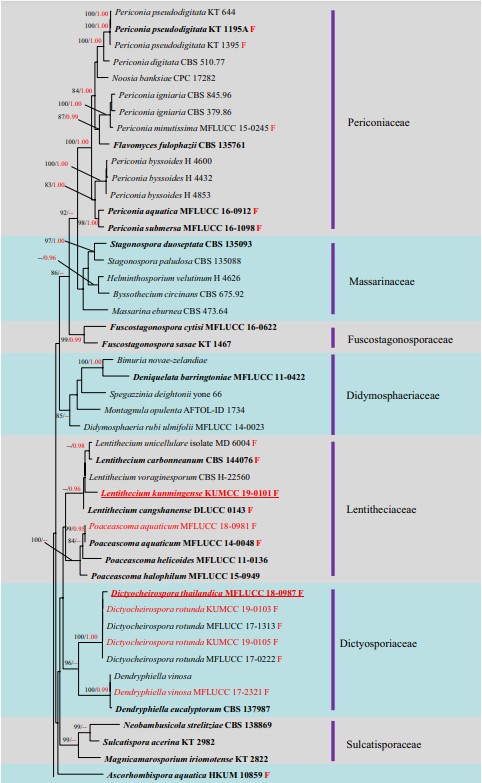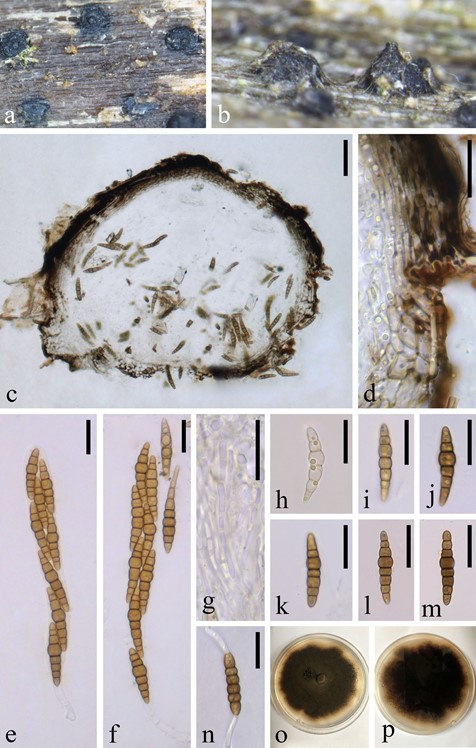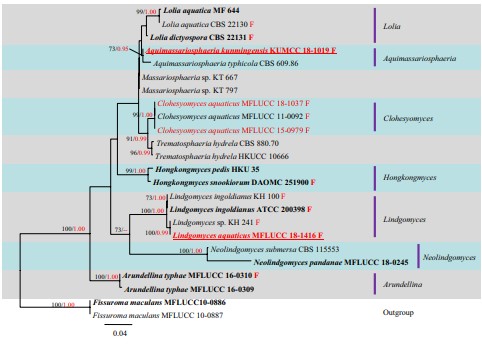Aquimassariosphaeria kunmingensis W. Dong, Doilom & K.D. Hyde, sp. nov.
MycoBank number: MB 557912; Index Fungorum number: IF 557912; Facesoffungi number: FoF 08734; Fig. 56
Etymology: referring to Kunming, where the holotype was collected
Holotype: HKAS 102148
Saprobic on decaying wood submerged in freshwater. Sexual morph: Ascomata 300–350 × 370–400 μm, scattered or solitary, erumpent, mostly superficial, subglobose to ellip- soidal, black, coriaceous, with ostiolate papilla. Peridium 30–40 μm thick, two-layered, outer layer comprising 4–6 layers of dark brown or black, thin-walled, compressed cells of textura angularis or irregular cells, inner layer comprising 3–5 layers of pale brown to hyaline, thin-walled, large cells of textura angularis. Pseudoparaphyses 2 μm diam., numerous, cellular, hyaline, unbranched, septate, embedded in a matrix. Asci 160–200 × 15–18 μm (x̄ = 180 × 17 μm, n = 5), 8-spored, bitunicate, narrowly clavate, short pedicellate, apically rounded. Ascospores 35–46(–55) × 6.5–9.5 μm (x̄ = 40 × 7.8 μm, n = 25), bi- to tri-seriate in the upper part, uni- seriate in the lower part, narrowly fusiform or vermiform, occasionally narrowly clavate with elongate basal cells, with rounded ends, brown, 6–7-septate, occasionally 5- or 8-septate, constricted at the septa, asymmetric, obviously enlarged at the third or fourth cell from the apex, straight or curved, smooth, thin-walled, without a sheath. Asexual morph: Undetermined.
Culture characteristics: On PDA, colony circular, reaching 10 mm in 15 days at 25 °C, black from above, dark brown from below, surface rough, with sparse mycelium, mostly immersed in culture, dry, raised, edge entire.
Material examined: CHINA, Yunnan Province, Kunming University of Science & Technology, on submerged wood in a stream, 10 May 2017, C.X. Liu, L47 (HKAS 102148), living culture KUMCC 18-1019.
Notes: Aquimassariosphaeria kunmingensis clusters with A. typhicola with moderate bootstrap support (Figs. 2, 61). Aquimassariosphaeria kunmingensis has superficial ascomata and thin-walled, smooth ascospores without a sheath, while the latter has completely immersed ascomata that staining substrate purple and thick-walled, heavily grained sculpted ascospores with a well-defined, mucilaginous sheath (Leuchtmann 1984). Comparison of single genes between A. kunmingensis (KUMCC 18-1019) and A. typhicola (CBS 609.86) shows that there are 4, 1 and 16 nucleotide differences in LSU, SSU and RPB2 sequence data, respectively, which supports them to be different species.

Fig. 2 Phylogram generated from maximum likelihood analysis of combined LSU, ITS, TEF and RPB2 sequence data for species of Dothideomycetes. Bootstrap values for maximum likelihood equal to or greater than 75% and Bayesian posterior probabilities equal to or greater than 0.95 are placed near the branches as ML/BYPP. Newly generated sequences are in red and ex-type strains are in bold. The new species introduced in this study are indicated with underline. Freshwater strains are indicated with a red letter “F”. Orders not treated in this study are compressed. The tree is rooted to Capronia pilosella AFTOL-ID 657 and Endocarpon pallidulum AFTOL-ID 661 (Eurotiomycetes)

Fig. 56 Aquimassariosphaeria kunmingensis (HKAS 102148). a, b Appearance of ascomata on host substrate. c Vertical section of ascoma. d Structure of peridium. e, f Bitunicate asci. g Pseudoparaphyses. h–m Ascospores. n Germinated ascospore. o, p Colony on PDA (left-front, right-reverse). Scale bars: c = 50 μm, d–n = 20 μm

Fig. 61 Phylogram generated from maximum likelihood analysis of combined LSU, SSU, ITS, TEF and RPB2 sequence data for species of Lindgomycetaceae. Bootstrap values for maximum likeli- hood equal to or greater than 70% and Bayesian posterior probabilities equal to or greater than 0.95 are placed near the branches as ML/BYPP. Newly generated sequences are in red and ex-type strains are in bold. The new species introduced in this study are indicated with underline. Freshwater strains are indicated with a red letter “F”. The tree is rooted to Fissuroma maculans (MFLUCC10-0886 and MFLUCC10-0887) (Aigi alaceae)
